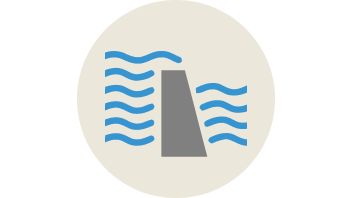Dam failures
A dam failure resulting in a sudden release of water can cause death and property damage downstream from the dam.
Learn what to do if a dam breaks.
Hazard information
A dam is a structure that holds back water in a river, lake, pond or stream. Dams are made of concrete, timber cribs filled with rocks or steel sheet piling. They can also be formed from a bank of earth or rock fill.
Dams are used to:
- produce hydropower
- support recreation and tourism
- support navigation
- mitigate high or low water levels
- limit the spread of invasive species
- support wetland habitat management
Extreme floods are a primary cause of dam failure. When lake and river levels rise due to extreme rainfall or extensive snow runoff, water levels can exceed the capacity of the dam. If the dam fails, the flood situation gets worse.
Safety tips
If you’re an individual:
Awareness is your best defence. If you notice warning or caution signs at the dam site, follow the instructions, stay back and leave the area.
If you live, work, or play near a dam, stay informed by listening to the latest warnings and advisories on the radio and television.
Contact local authorities immediately if you notice:
- dam failure due to structural issue, human error or natural extreme events
- a washed out or unsafe water bridge
- stored water released in an uncontrolled manner
- potential danger to people or watercrafts on, around or near dams
- observations such as, muddy water, ice jams, water over the dam deck and/or debris build up
If you’re a dam owner:
Practice your emergency preparedness plans annually to ensure you are ready to implement them during a dam failure emergency.
The Ministry of Natural Resources provides technical guidance and best management practices for design, construction, operation, maintenance and safety of dams.. This includes guidance on dam safety, the identification of public safety hazards associated with dams, and how to eliminate or mitigate these hazards.
Prepare now
Take the following steps so you and your family are prepared in the event of a dam failure:
- Contact your local municipality to learn more about your community’s emergency response planning process.
- Learn and practice evacuation routes, shelter plans and flash flood response.
- Keep important documents in a waterproof container. Create password-protected digital copies.
- Monitor for potential causes of dam failure, such as heavy rain, and regularly check your local community warning system.
